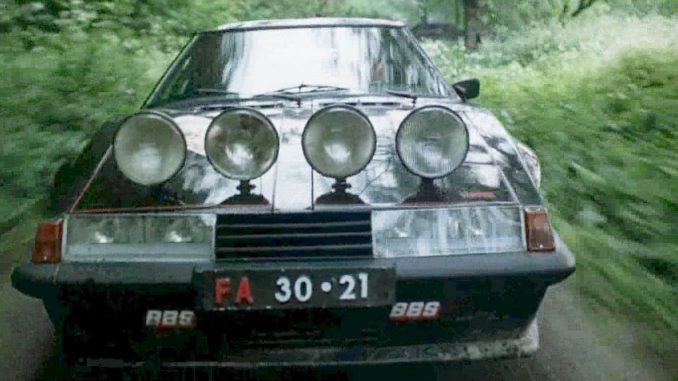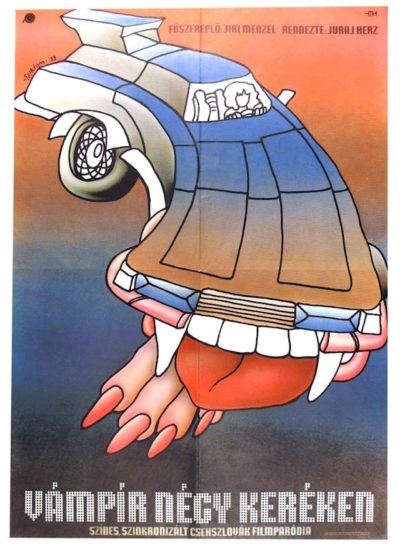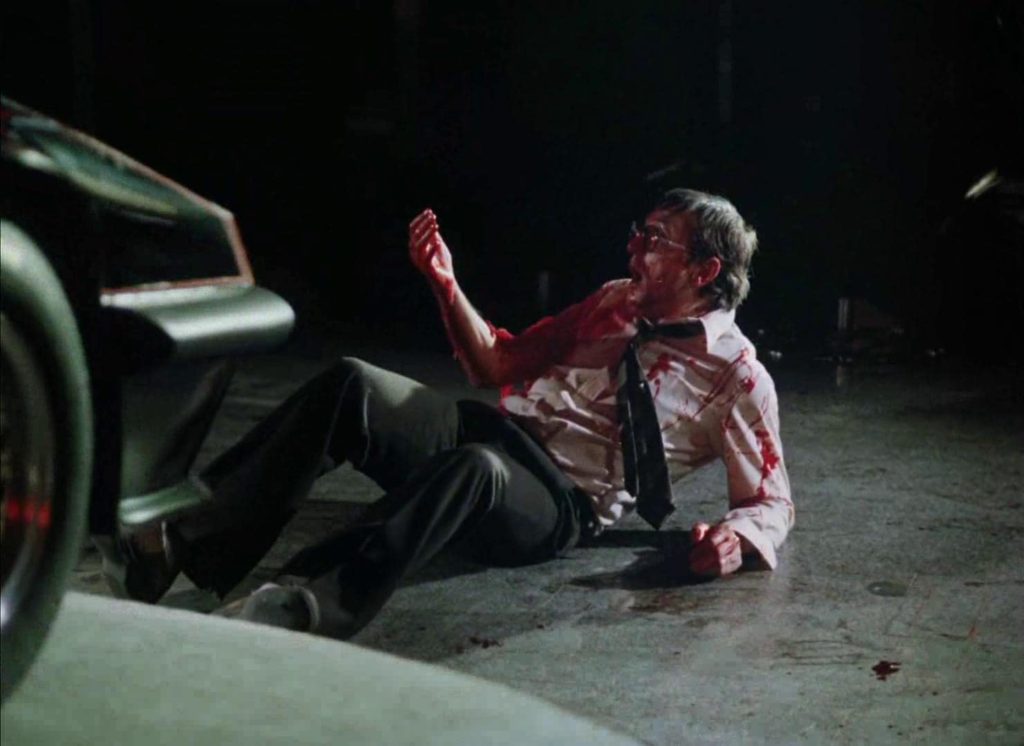
Rating: C+
Dir: Juraj Herz
Star: Jiří Menzel, Dagmar Veškrnová, Jana Břežková, Jan Schmid
a.k.a. Upír z Feratu
I really wanted to include a Hungarian vampire movie in this feature. Along with Romania, the country is the effective birthplace of the modern myth and all, between Countess Bathory and Bela Lugosi. However, the sole “true” Hungarian vampire production listed by Wikipedia is 1921 silent movie, Dracula’s Death, and since that is regarded as lost, it’s not much help. Otherwise, the only one to come to mind is Comrade Dracula, and I already reviewed that. Metamorphosis does have a Hungarian director and was shot there, but… nah. It’s almost as if the local film industry rolls its eyes at the caped cliches, in much the same way Scotland deferred to Hollywood to make Braveheart and Rob Roy.
As a geographically approximate stand-in, we move to the Czech Republic – or Czechoslovakia as it was known at the time this was made, back when it was still a satellite of the Soviet Union. Though this is certainly very far from a conventional vampire tale. The opening credits make this clear: I’m fairly certain it is the only film in cinematic history to include the line there, “This movie was filmed during the 8th International SKODA 81 Rally.” Yes, Skodas. That butt of car culture humour around the time, likely only half a step above its Eastern European counterpart: “How do you double the value of a Lada? Fill the petrol tank”. However, if any movie can perhaps redeem the reputation of those poorly-constructed hunks of metal, perhaps this might.
 For the Skoda in this case is a vampire. Yeah, you read that correctly. It’s probably the first example of a vehicle which uses human blood for fuel, though was certainly not the last. There was Blood Car in 2007; Road Kill in 2010; and TV series Blood Drive went the same route in 2017. However, the one I know and love best is horror-comedy I Bought a Vampire Motorcycle, from 1990. There, the bike was transformed by a Satanist bleeding into its petrol-tank. Here, the vehicle in question has been deliberately created by its manufacturers, in response to the rising price of fuel. The original Czech title is a pun on “Upír Nosferatu”, which translates as Nosferatu the Vampire.
For the Skoda in this case is a vampire. Yeah, you read that correctly. It’s probably the first example of a vehicle which uses human blood for fuel, though was certainly not the last. There was Blood Car in 2007; Road Kill in 2010; and TV series Blood Drive went the same route in 2017. However, the one I know and love best is horror-comedy I Bought a Vampire Motorcycle, from 1990. There, the bike was transformed by a Satanist bleeding into its petrol-tank. Here, the vehicle in question has been deliberately created by its manufacturers, in response to the rising price of fuel. The original Czech title is a pun on “Upír Nosferatu”, which translates as Nosferatu the Vampire.
It begins with ambulance doctor Marek (Menzel) and his driver Mima (Veškrnová) out on patrol, when they see the site of a crash, where race-car driver Luisa Tomášová (Břežková) has driven her vehicle off the road. Before they can do anything, her car company’s own ambulance has swept in, taking Luisa away. Marek later discovers Luisa was pronounced dead, though the autopsy results are weird: “It’s like someone bit her foot off.” Mima, who always harboured an ambition to be a racing driver herself, is recruited as Luisa’s replacement, and quickly begins behaving strangely, which deepens Marek’s concerns. He’s then contacted by Dr. Kaplan (Schmid), who reveals the unbelievable and horrible truth about the vehicle in question: it runs on human blood.
Specifically, the accelerator pedal is its “fang”, through which it draws from the driver. As Kaplan explains, with the convenient help of a silent vampire movie, the victim becomes addicted to the experience, and gradually turns into a zombie (though as used in the film, the effect is more like becoming one of Dracula’s brides). It’s difficult for Marek to believe, but Luisa’s twin sister Klára (also Břežková), asks for his help, feeling there was something odd about her sibling’s death. He tries to inspect the car, but is stymied by the corporation at every turn. First they try to buy Marek off, then let him inspect a decoy model, running on normal petrol, and it becomes a race against time to try and free Mima from the clutches of the car and the evil corporation which made it.
I like the idea here a lot. It’s a very different kind of “vampire,” and there are no supernatural trappings at all. The usual tropes are absent: daylight, crosses and garlic have no effect. When Marek mentions them to Kaplan, he’s sternly rebuked: “You’re making fun of it, but this is a serious matter!” Instead, this is all to do with what Kaplan calls “biological machinery”, and there are significant elements which feel distinctly Crononbergian. These even include the automobile element, since perhaps Cronenberg’s most obscure feature is 1979’s Fast Company, about drag racing. And just two days ago, we reviewed Rabid, in which “biological vampirism” occurs as a result of a misplaced medical procedure. This feels like someone decided to combine remakes of both.
 Guess we should be grateful we don’t get into any Titane-like sex with cars. Instead, there is a particularly trippy dream sequence for Marek (above), where he goes to inspect the car, peeling back the bonnet to discover an organic, pulsing interior into which he is pulled. We could add Videodrome to the list of influences on this – except it didn’t come out until the following year, so never mind. I just wish the movie had kept going down this road, as the first half is genuinely inventive and engaging. Instead, the second half all but grinds to a halt by the side of the road, with far too much footage of Skodas racing each other through the Czech countryside. Quotes around “racing” are likely warranted. There’s also a po-faced lecture on road accidents.
Guess we should be grateful we don’t get into any Titane-like sex with cars. Instead, there is a particularly trippy dream sequence for Marek (above), where he goes to inspect the car, peeling back the bonnet to discover an organic, pulsing interior into which he is pulled. We could add Videodrome to the list of influences on this – except it didn’t come out until the following year, so never mind. I just wish the movie had kept going down this road, as the first half is genuinely inventive and engaging. Instead, the second half all but grinds to a halt by the side of the road, with far too much footage of Skodas racing each other through the Czech countryside. Quotes around “racing” are likely warranted. There’s also a po-faced lecture on road accidents.
Given the setting and the era, I suspect it’s all intended to be a poke at the perils of unfettered capitalism, literally using the working classes as fodder to power the machine. However, I feel it needed to buy much more into the weirdness of the concept. I’d like to have seen more of the machine in action, with Kaplan and Marek becoming the equivalent of Van Helsing, and events building to some rage against the machine. Instead, it peters out in a manner which is all the more disappointing, given how well this started. Much like communism, films about vampire cars may work better in theory than practice.
This review is part of our October 2023 feature, 31 Days of Vampires.
